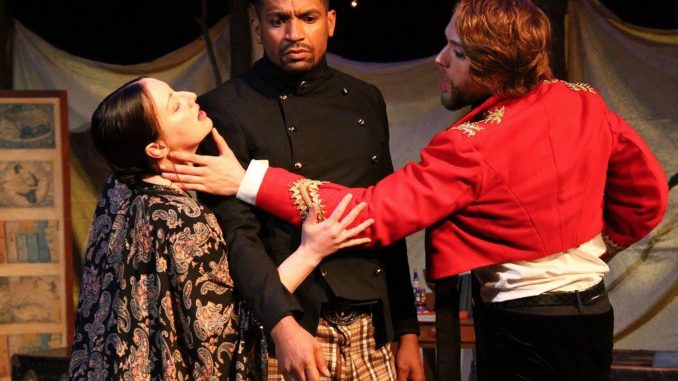
Brenna Geffers doesn’t consider herself an expert on Russian literature.
But for one of her most recent theater productions, “Anna,” Geffers, a 2009 master’s of directing alumna, adapted all 864 pages of the tragic novel “Anna Karenina” by 19th-century Russian author Leo Tolstoy.
The play, which ran at EgoPo Classic Theater on Vine Street near 12th last spring, uses eight characters to tell Tolstoy’s famously intricate plot, which is based in the title character’s fight for gender equality.
Geffer’s adaptation was nominated for four Barrymore Awards for Excellence in Theatre this past August, including Outstanding Direction of a Play, Outstanding Ensemble in a Play, Outstanding New Play/Musical and Outstanding Choreography/Movement. The winners were announced Oct. 30. Although the play didn’t win in any categories, it was received enthusiastically by audiences.
“On opening night the crowd leaped to their feet in applause,” said K. O’Rourke, a second-year master’s of acting student and the choreographer for “Anna.”
Theatre Philadelphia, an organization that connects Philadelphia’s growing theater community, presents the Barrymore Awards. These are prestigious, nationally recognized awards for exceptional theater in the Philadelphia region.
In “Anna Karenina,” the title character strays away from traditional societal expectations by abandoning her family and her domestic sphere for an affair with another man. She experiences the consequences of her actions, including disapproval from her family and friends, the eventual failure of the affair and the torment these things cause her. The show ends with Karenina jumping in front of a moving train, causing her death by suicide.
Geffers’ inspiration for adapting the play began last season with EgoPo Artistic Director Lane Savadove’s desire to create a season of shows based on the work of Russian writers, primarily Anton Chekhov, Fyodor Dostoyevsky and Tolstoy.
“I wanted to do the play so that [EgoPo] would have a play with a central female character, rather than just all male heroes,” Geffers said. “There are many pieces that are revered as these great classics that, as a woman, I can’t find myself in.”
For Geffers, it is always very important to have a strong purpose for creating a show. She said this often means having her principles reflected in the work.
Geffers recognized the inequality of Anna’s struggle in the novel as other male characters’ actions in the story weren’t restricted. Their characters were even permitted to have affairs with little consequence.
“It’s about a woman striving for humanity,” Geffers said. “I had no intentions on working with this book. It just suddenly became the right choice to do right now.”
Geffers began to work on her adaptation during the 2016 presidential election. The theme of inequality between men and women became particularly relevant to her and the play as the campaign unfolded.
“I just felt so tired,” she said. “I was so tired of stories of women striving and failing.”
For this reason, Geffers decided to take her own liberties with the story, following the general plot line, but setting the show in a different time period.
Geffers adapted Tolstoy’s novel into a play about a group of “pseudo-intellectual” activists in the late 1960s putting on a production of “Anna Karenina.”
“It’s very rare to find directors like Brenna, who are very sensitive to the original text, but are also very bold in their directorial approach at the same time,” Savadove said.
Geffers altered the time period so the story could be more recognizable for younger audiences. She wanted to highlight the change happening with women’s rights in late 19th-century Russia in the original novel. She found this to resonate with dialogue happening today about women’s rights after the 2016 presidential election.
“She’s not afraid to bend a story to her own sense of morality or her own sense of politics,” said Thom Weaver, light designer for “Anna.” “She’s not interested in inevitabilities in storytelling, especially when those inevitabilities are crafted by patriarchal society.”
Geffers tries to cultivate work with a “female gaze,” as opposed to a “male gaze,” a term developed by feminist film theorist Laura Mulvey to describe the historical tendency in art to depict life and women from a heterosexual male point of view.
The female gaze refers to the differing perspective that a female filmmaker brings on set compared to a male view of the subject.
“There’s a group of actors I tend to work with a lot, and we talk a lot about how to cultivate the female gaze, and what that means, physically, sexually, spiritually,” Geffers said.
Geffers also radically changed the ending of the play. In her adaptation, Anna decides against taking her own life and watches the train fly past her.
In the end, Anna is tired of telling stories about women seeking and ultimately failing to achieve equality. But she recognizes that if she stops there, then the potential for achieving gender equality would stop too.
“The show ends with this line: ‘We’ll have to try again,’” Geffers said.
For Geffers, this line became a theme for not only the show, but for work that needs to be done regarding the struggle for equality today.
“This idea became a central image for me in why I wanted to tell the story and an essential theme of the show,” Geffers said. “It can be difficult to try to look at the world through a different gaze, through a different set of eyes. It’s tricky, but I think it’s worth it.”



Be the first to comment